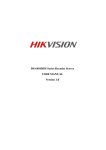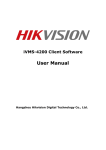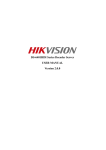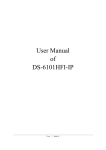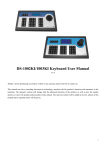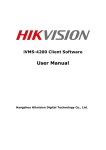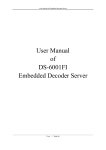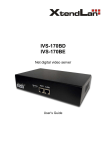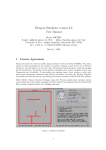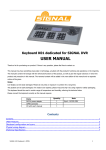Download User Manual of DS-6301/6304/6308DI
Transcript
DS-630XDI Series Decoder Server USER’S MANUAL Version 2.0.0 Hikvision® Network Digital Video Recorder User’s Manual This manual, as well as the software described in it, is furnished under license and may be used or copied only in accordance with the terms of such license. The content of this manual is furnished for informational use only, is subject to change without notice, and should not be construed as a commitment by Hikvision Digital Technology Co., Ltd. (Hikvision). Hikvision assumes no responsibility or liability for any errors or inaccuracies that may appear in the book. Except as permitted by such license, no part of this publication may be reproduced, stored in a retrieval system, or transmitted, in any form or by any means, electronic, mechanical, recording, or otherwise, without the prior written permission of Hikvision. HIKVISION MAKES NO WARRANTIES, EXPRESS OR IMPLIED, INCLUDING WITHOUT LIMITATION THE IMPLIED WARRANTIES OF MERCHANTABILITY AND FITNESS FOR A PARTICULAR PURPOSE, REGARDING THE HIKVISION SOFTWARE. HIKVISION DOES NOT WARRANT, GUARANTEE, OR MAKE ANY REPRESENTATIONS REGARDING THE USE OR THE RESULTS OF THE USE OF THE HIKVISION SOFTWARE IN TERMS OF ITS CORRECTNESS, ACCURACY, RELIABILITY, CURRENTNESS, OR OTHERWISE. THE ENTIRE RISK AS TO THE RESULTS AND PERFORMANCE OF THE HIKVISION SOFTWARE IS ASSUMED BY YOU. THE EXCLUSION OF IMPLIED WARRANTIES IS NOT PERMITTED BY SOME STATES. THE ABOVE EXCLUSION MAY NOT APPLY TO YOU. IN NO EVENT WILL HIKVISION, ITS DIRECTORS, OFFICERS, EMPLOYEES, OR AGENTS BE LIABLE TO YOU FOR ANY CONSEQUENTIAL, INCIDENTAL, OR INDIRECT DAMAGES (INCLUDING DAMAGES FOR LOSS OF BUSINESS PROFITS, BUSINESS INTERRUPTION, LOSS OF BUSINESS INFORMATION, AND THE LIKE) ARISING OUT OF THE USE OR INABILITY TO USE THE HIKVISION SOFTWARE EVEN IF HIKVISION HAS BEEN ADVISED OF THE POSSIBILITY OF SUCH DAMAGES. BECAUSE SOME STATES DO NOT ALLOW THE EXCLUSION OR LIMITATION OF LIABILITY FOR CONSEQUENTIAL OR INCIDENTAL DAMAGES, THE ABOVE LIMITATIONS MAY NOT APPLY TO YOU. Preventive and Cautionary Tips Before connecting and operating your DVR, please be advised of the following tips: • Ensure unit is installed in a well-ventilated, dust-free environment. • Keep all liquids away from the DVR. • Please check the power supply to avoid the damage caused by voltage mismatch. • Please make sure the DVR work in the allowed range of temperature and humidity. • Please keep the device horizontal and avoid the installation under severe vibration environment. • The dust board will cause a short circuit after damping; Please dedust regularly for the board, connector, chassis fan etc with brush. TABLE OF CONTENTS C H A P T E R 1 ........................................................................................................................ 6 Introduction ............................................................................................................................... 6 1.1 Description ...................................................................................................................... 7 1.2 Features ........................................................................................................................... 7 C H A P T E R 2 ...................................................................................................................... 10 Structure .................................................................................................................................. 10 2.1 Front Panel .................................................................................................................... 11 2.2 Rear Panel...................................................................................................................... 11 2.3 Alarm Connections ........................................................................................................ 12 2.3.1 Alarm Input Connections ....................................................................................... 12 2.3.2 Alarm Output Connections ..................................................................................... 12 2.3.3 Signal Line Connections......................................................................................... 13 C H A P T E R 3 ...................................................................................................................... 14 Network Parameters Configuration ......................................................................................... 14 3.1 Hyper Terminal Setup ................................................................................................... 15 3.2 Network Configuration by Hyper Terminal .................................................................. 17 C H A P T E R 4 ...................................................................................................................... 19 Decoder Configuration ............................................................................................................ 19 4.1 Decoder Configure Software ......................................................................................... 20 4.2 Add Decoder.................................................................................................................. 21 4.3 Decoder Configuration .................................................................................................. 22 4.4 TV Wall Settings ........................................................................................................... 24 4.5 Decoder control ............................................................................................................. 26 4.5.1 Video decode control .............................................................................................. 28 4.5.2 Cycle decoding control ........................................................................................... 29 4.5.3 PTZ control............................................................................................................. 31 C H A P T E R 5 ...................................................................................................................... 32 Appendix ................................................................................................................................. 32 Appendix A Specifications ............................................................................................... 33 Appendix B FAQ.............................................................................................................. 35 Appendix C Glossary ....................................................................................................... 36 C HAPT E R 1 Introduction 1.1 Description Developed by Hikvision based on TI DM648 platform, DS-630XD is a kind of multi-purpose video/audio decoder which is capable of allowing the coded images from HIK DVR/DVS or other encoding devices to be decoded and displayed on the TV wall after transmission via IP network. Specially designed for the allocation and management of the video surveillance system, DS-630XD supports multiple network transmission protocols, and it applies the code downloaded in FLASH, ensuring high stability and reliability of system performance. DS-630XD Video/Audio Decoder adopts highly integrated TI DM648 processing chip which provides powerful decoding capability. It supports multiple bitrate transmission methods, and is capable of decoding /outputting the high-definition 720P video stream and decoding images at 4CIF/DCIF/2CIF/CIF resolution, as well as outputting decoded images via BNC and VGA ports simultaneously. In addition, the Decoder also provides capabilities such as voice talk, alarm input/output, PTZ control, etc., maintaining powerful support for the large TV wall decoding service. 1.2 Features Decoding Decoding images and audio Support HIK H.264, standard H.264 and MPEG4 image compression formats; Support PS, RTP and HIK customized encapsulation formats Support PAL and NTSC image formats Support decoding at 720P, VGA, SVGA, 4CIF, 2CIF, DCIF, CIF and QCIF image resolutions Support audio decoding at OggVorbis formats Decoding Resources DS-6308DI is capable of decoding 16 streams at CIF/8 streams at 4CIF/4 streams at 720P, and it adopts 8 BNC and 4 VGA outputs, of which BNC output supports 1/2/4 multi-camera display and main VGA output supports 1/2/4/9/16 multi-camera display, and other VGA outputs support 1/2/4 multi-camera display. DS-6304DI is capable of decoding 8 streams at CIF/4 streams at 4CIF/2 streams at 720P, and it adopts 4 BNC and 2 VGA outputs, of which BNC output supports 1/2/4 multi-camera display, main VGA output supports 1/2/4/9 multi-camera display, other VGA output support 1/2/4 multi-camera display. DS-6301DI is capable of decoding 4 streams at CIF/2 streams at 4CIF/1 streams at 720P, and it adopts 1 BNC and 1 VGA output, of which BNC output support 1/2/4 multi-camera display, main VGA output supports 1/2/4 multi-camera display. Decoding Mode Multiple bitrate transmission methods: support TCP, UDP, multi-cast and RTP transmission methods when the HIK customized protocols are adopted; and support RTP over TCP and RTP over UDP when standard H.264 and MPEG4 are adopted. Dynamic decoding: dynamically input encoder’s IP address and switch decoding channels; maintain rapid decoding and switch. Cycle decoding: set multiple remote monitoring channels on a decoding channel, and the decoder is capable of performing cycle decoding according to the configured sequence and time. The stream sources can be obtained via remote access to the encoder or stream media server and decoded for local output. A maximum of 64 channels are allowed for cycle decoding. Obtain stream from stream media: receive real-time data by remote access to HIK stream media server, and then decode stream for local output. Remote playback of encoder’s record files: by remote access to the encoder with storage capability, and directly obtain the record files from the encoder, and finally decode for local output. Passive decoding: the decoder passively receives stream sources, and then proceeds decoding and transmission. Passive decoding supports TCP and UDP transmission modes. Network One 10/100/1000Mbps self-adaptive UTP Ethernet interface Support TCP/IP, UDP and RTP network protocols. Get allocated IP address, sub mask and gateway via DHCP server. Accomplish auto time adjustment for decoder through NTP protocol Support DDNS capability Capable of searching decoder in real time through SADP software, as well as modifying the IP address, sub mask, gateway of decoder and some other parameters. Capable of accessing decoder by TELNET command to view device information, modify network parameters, etc. Alarm Relay Alarm Input The decoder provides alarm input/output ports in relay signal input mode which can be set to NO or NC. Four different arming periods can be set, in which the alarm occurs, the device is capable of triggering corresponding alarm handling method, relay output and buzzer alarm, as well as upload to center, etc. Relay Alarm Output The relay alarm output can be connected to alarm devices for alarm response actions, e.g., combined aural and visual alarm unit, etc., which is capable of proceeding alarm handling within the arming period. Exception Handling Exception Alarm Handling Exception alarms include network disconnect alarm, IP address conflict alarm, illegal access alarm, etc.; multiple alarm handling methods are supported: relay alarm output, buzzer alarm, upload to center, etc. Exception Reboot Software watchdog capability: for inspecting important threads and system resources of device; in case of exceptions cannot recovered, the device will be automatically rebooted. Firmware watchdog: for inspecting the firmware of device; in case of exceptions in system task scheduling, the device will be automatically rebooted. User Administration A maximum of 32 users can be created by the system, including 1 administrator and 31 users. The user name of the administrator is admin, which cannot be modified, and the password is allowable to be modified by the administrator only; no deletion of the administrator is allowed, and the administrator is authorized to set the operation permissions for normal users. SDK Interface Transparent Channel The decoder adopts the RS232/RS485 serial interface to realize transparent transmission. The data sent remotely to the decoder via network can be transmitted by RS232/RS485 interface of decoder without any handling, and the transparent channel of the decoder supports multi-cast transparent transmission as well, and multiple transparent channels can be established simultaneously. PTZ Control Through SDK transparent channel, the PTZ of DVR or DVS can be remotely controlled. Voice Talk The decoder is capable of realizing voice talk with the remote client. When the client has submitted application, the voice talk between the client and decoder is created. C HAPT E R 2 Structure 2.1 Front Panel 2.2 Rear Panel DS-6308D Rear Panel Interface Connections 1 VIDEO/AUDIO OUT BNC connectors for video/audio output 2 LINE IN 1 BNC connector for voice talk audio in, connects to active audio input device. 3 LINE OUT 1 BNC connector for voice talk audio out, connects to audio output device, e.g. sound box. 4 AUDIO-1 to AUDIO-4 The corresponding audio outputs of VGA1 to VGA4, BNC interface, connect to audio output device. 5 VGA VGA1 to VGA4 connect to monitor 6 RS232 Connect to RS-232 devices, e.g., PC, etc. 7 LAN 8 RS-485 9 ALAM IN 8 alarm inputs 10 ALAM OUT 8 alarm outputs 11 POWER 12 GND 10/100/1000Mbps self-adaptive UTP Ethernet interface RS-485 data connector 12V DC power supply Ground 2.3 Alarm Connections 2.3.1 Alarm Input Connections DS-630XD supports the open/close relay input as the alarm input mode. For the alarm input signal not in open/close relay signal mode, please follow the connections shown as below: Alarm input connections for Emerson Alarm: Alarm input connections for Normal Alarm: 2.3.2 Alarm Output Connections DS-630XD supports the open/close relay input as the alarm output mode. The alarm input can be selected to NO or NC. Different alarm output connection methods are applied to the AC or DC load, please refer to the following diagram: Alarm output connections diagram: Please note the different connections of JJ1 shown above. For DC load, JJ1ca be safely used both in NC and NO methods, and it is recommended to use within the limit of 12V/1A. For external AC input, JJ1 must be open. The motherboard provides two jumpers, each corresponding to one alarm output. And both of two jumpers are factory set to be connected. 2.3.3 Signal Line Connections DS-630XD Decoder provides the green terminal plug for connecting signal lines. Follow the instructions shown below: 1. Disconnect the green terminal plug from the terminal socket on the device; 2. Use the standard screwdriver to loosen the screws on the plug, and then insert signal lines to the plug and under the spring washers, and finally tighten the screws. 3. Connect the plug with signal lines to the corresponding green terminal socket. C HAPT E R 3 Network Parameters Configuration Description: This chapter is about the network parameters configuration of Hikvision DS-630XDI Decoder. The DS-630XDI factory default user name is admin, password is 12345. The DS-630XDI factory default IP address is 192.0.0.64. The network parameters need to be setup before the decoding channel configuration. The network parameters are used to connect with the software which is applied to set the decoding channels. The network parameters are including IP address, subnet mask, gateway and port. 3.1 Hyper Terminal Setup The common method is to connect decoder and PC with serial line, run Hyper Terminal and modify parameters with serial command. Please connect the RS-232 port of decoder with the COM port of PC directly, power on the decoder and PC and follow the steps: Step1: Enter Hyper Terminal. Click “Start”-> “Programs”->”Accessories”-> “Communications”->”Hyper Terminal” in Windows system, and the dialogue box below will appear as Figure 3.1.1. Figure 3.1.1 Step2: Name the connection and define the icon. Input a name (e.g. HK), select an icon, and press “OK” to enter “Connect To” dialogue box. Step3: Select the communication port. Select “COM1” in “Connect To” interface (Please select the COM port according to the reality, in case PC has more than 1 COM.). Press “OK” to enter “Properties” dialogue box. Figure 3.1.2 Step4: Serial port setup. Set port parameters in “COM1 Properties” dialogue box as follow: (Fig 3.1.3) Figure 3.1.3 The parameters should be: Bits per second: 115200 Data bits: 8 Parity: None Stop bits: 1 Flow control: None Press “Apply” and “OK” after the setup. Press “Enter” under Hyper Terminal interface. When “[root@dvrdvs/]#” appears, the connection is established. Figure 3.1.4 Step5: Disconnect and save connection According to the tips, disconnect and save “HK” for the next time. After saving, there will be a new “Hyper Terminal” item established in the program group “Start”-> “Accessories”->“Communications”->“Hyper Terminal”. “Connection” names of all Hyper Terminal are included. You can see an icon named as “HK” here. 3.2 Network Configuration by Hyper Terminal Enter Hyper Terminal Click “Start”->“Programs”->“Accessories”->“Communications”->“Hyper Terminal”->“HK”, then the Hyper Terminal interface will appear as figure below. Type “Enter”, and the prompt “[root@dvrdvs/]#” will appear which means connection between RS232 interface of PC and RS232 interface of DS630XDI is established successfully by Hyper Terminal. The following operation commands are to accomplish the parameters setup in the prompt. Figure 3.2 Commands Description: Commands Utilities helpm Console help command is used to print common commands, show as Figure 3.2. getIp Show the current IP address of decoder. Command format: getIp “Enter”. setIp Setup decoder IP address. Command format: setIp IP: mask, e.g. setIp 192..168.1.11:255.255.255.0 getGateway Show current decoder gateway address. Command format: getGateway “Enter”. setGateway Setup decoder gateway. Command format: setGateway Gateway, e.g. setGateway 192.168.1.1 getTime Show decoder current time. Command format: getTime “Enter”. setTime Setup decoder time. Command format: setTime 2009-11-2:12:20:04 showBootTime Show decoder boot time. Command format: showBootTime “Enter”. showUserInfo Show decoder current user information. Command format: showUserInfo “Enter”. Note: These are only common commands. The other commands please consult our technical engineers. CHAPTER4 Decoder Configuration Instruction: Before configuration, user need to do the network configure according to the chapter 3. Connect the decoder to the LAN. Prepare a PC connected to the same LAN with the decoder. 4.1 Decoder Configure Software Please open the accessory to get the disk, there is the iVMS4000 V2.0 software in it supplied by HIKVISION, please double click the icon to set up it. The following section has described the configuration of decoder through the software. Please refer to the user manual of iVMS 4000 V2.0 for more details. The following figure shows the interface after access to the software: Figure 4.1 software interface Note: this software is supplied by HIKVISION for configuration of the decoder; though it also has the function of configuring the encoder, this chapter only instructs the decoder configuration. For other instructions, please refer to the user manual of iVMS 4000 V2.0. 4.2 Add Decoder Click “ “ ”, and then click ” to enter the decoder setting interface. Right click the “Decoder list”, and select “Add decoder”, or click “ ”to add decoder. Input decoder name, IP, Port, Username, Password, and click ”OK” to finish adding decoder. Option Decoder type Instruction CIF, 4CIF, 720P can be selected. This option is effective to 6300DI Decoder, used for source distribute. It’s not effective to 6000DI. Decoder name The name of the Decoder, it can be user-defined. Decoder IP The IP address of the Decoder Port The device port of the Decoder Username/Password The username and password of the Decoder. 6300DI decode source as below, detail description refers to the decoder user manual. Decode type CIF 4CIF 720P Instruction 6301DI supports 4-channel decoding, 6304DI supports 8-channel decoding, 6308DI supports 16-channel decoding. 6301DI supports 2-channel decoding, 6304DI supports 4-channel decoding, 6308DI supports 8-channel decoding. 6301DI supports 1-channel decoding, 6304DI supports 2-channel decoding, 6308DI supports 4-channel decoding. After added successfully, the decoder channels will be displayed in the decoder list. 6300DI Series decoder supports VGA, so it displays the BNC and VGA outputs differently Right click a decoder and select “Modify decoder” or click “ ”, user can modify the decoder; select Delete decoder, or click “ ” to delete it. Note:Each decoder is recommended to be added in one iVMS-4000 software only, avoiding disordered control caused by one decoder added in multiple software terminals. 4.3 Decoder Configuration Select a decoder, right click it and select “Remote Settings” to enter the decoder “Remote setting” interface. Export/import config file Right click a decoder, user can select “Export device config file” and save the device configuration file in “C:\SaveRemoteCfgFile” folder by default. If user has saved the config file before, select “Import config file to device” to import the existed configuration to the decoder. Decoder Status Select “Decoder work status”, the status of decode will be displayed in the following list. 4.4 TV Wall Settings Enable/Disable decode output After adding decoder, the decode channel is not in use by default. Drag the channel to the blank interface on the right, it will enable this channel. When a channel is enabled, clicking “ ” on the right and bottom corner may disable this channel. Decode output settings By double clicking a channel of the decoder, user can configure the channel name and CVBS output format to be PAL or NTSC. The VGA output can configure resolution. Window division configuration the By right clicking the decoder channel, user can change the division mode. The section will be different depend on the device type. Shown as below: Decode channel Output division No. 630xDI: BNC output 1, 4 6301DI: VGA output 1, 4 6304DI VGA1 output 1,4,9 VGA2 output 1,4 VGA1 output 1,4,9,16 VGA2,3,4 1,4 6308DI output After configuration of the window division, if it has reached the limit of decoding source, then when the user continues to enable the decode output channel, the system will display the warning message of “decoder channel not available!” For example, in the CIF decoding type, the first two channels of 6304DI (8-channel decoding at 6308DI, the former 4 BNC and the last 4 BNC out CIF) have been configured with quad display, then when user tries to enable the third decoding output, the system will pop up the error message dialog box. Decode output Total decode source BNC1-BNC4 output CIF: 8-channel 4CIF: 4-channel 720P: 2-channel BNC5-BNC8 output CIF: 8-channel 4CIF: 4-channel 720P: 2-channel VGA output CIF: 16-channel 4CIF: 8-channel After configuration of the window division, if it does not reach the limit of decoding source, when enabling decode output and exceeding decoding source, then the exceeded window will be invalid. For example, in the CIF decoding type, the first three channels of 6304DI (8-channel decoding at CIF) have been configured with 6 windows decoding, it is possible for the user to enable the fourth decoding output, but after 4 windows division of this output, the last two decoding window will be invalid. 720P: 4-channel Decode channel position management After having enabled decode output and configured the division, user can change the size and position of the display window. Click the mouse and hold on the title below the window to change its position. By dragging a border of the decoder, user can change the size of the window. You can also use the layout toolbar to adjust the size and position. Layout toolbar description: Button Description Button Description Flush Left Flush Right Flush Top Flush Bottom Vertical Center Horizontal Center Same Horizontal Interval Same Vertical Interval Same Width Same Height Same Dimension 4.5 Decoder control After adding decoder configuration, click the icon to enter decoder control interface. Area Description Area Description Device list PTZ Preset list Decode channel display Decode channel video Decode channel state display display Enter TV Wall control interface, the decode channel area will display as user-defined. Click decode video and states, or click to hide the to resume. The buttons related to the interface are described below: Button Description Button Description Start to play the decode video Stop to play the decode video Start to cycle decode Stop to cycle decode Start/Stop the local decoded image Capture preview Record 4.5.1 Video decode control Select the decode window, drag one channel into it and the decoder will start decoding this channel. The decoder video display area will display the real-time video, and the state area will display the states of current decoding. Stop decoding Right click the decode channel, select “Stop decoding” or click “ ” to stop current decode division. Start decoding After stopped, user can right click this division and select “Start decoding” or click “ ” to resume decoding. Voice control Right click the decoding window, choose ”Open voice” to open voice; When the voice is on, right click the decoding window, choose “Close voice” to close voice. Attention: Only the stream type “Audio & Video” can support the function “Open voice”. Decoding image control Choose the decoding window, and the image display area will show the current decoding image. Click icon to stop image display .When the image display is off, click When in preview state, click to start the image display. to capture the current picture for local storage. Click the icon recording and then the state of the icon will be to start , click again to stop recording. 4.5.2 Cycle decoding control Select a window division of a decoder, drag one device node to it, then this decode division will cycle decode all the channels of this device. The decoder video display area will display the real-time video, and the state area will display the states of current decoding. Pause cycle decoding Right click the cycle decoding window, select “Pause cycle decoding” or click “ ” to pause the cycle decoding. Resume cycle decoding When the cycle decoding is off and right click on the decoding window, select “Resume cycle decoding” or click “ ”, it will start decoding again. Configure the cycle decoding time Click the icon ”Setup”—“Software configuration” to configure the cycle decoding time. The default cycle time is 20s. After configuring the time , click the icon ”save” to save the configuration. 4.5.3 PTZ control If the decoder connected PTZ, user can operate the PTZ through this software. There are 8 keys to control PTZ directions, and the active bar to change PTZ speed, which is adjustable from 1 to 7, and default speed is 4. Click key to start auto scan. Click the function keys on the right to adjust focus, iris and zoom. If PC connected with 1002K/1003K keyboard or USB joystick, the PTZ can also be controlled by them. Note: When a division is in cycle decoding, PTZ control will pause, after PTZ control over, cycle decoding will resume. Call preset BY double clicking the existed preset, it will transfer the preset of current device. C HAPT E R 5 Appendix Appendix A Specifications DS-6301D Video Compression H.264、 MPEG4 Audio Compression OggVorbis Decode Resolution QCIF/CIF/2CIF/DCIF/4CIF/ 720P 1-ch, BNC (1.0Vp-p,75Ω) Video Output PAL:1/16~25fps, Frame Rate NTSC: 1/16~30fps Stream Type Video/Video & Audio Audio Output 2-ch, BNC, 600Ω VGA Interface 1-ch, Resolution 1280×1024×60Hz,1280×720×60Hz Or 1024×768×60Hz Communicati-on 1 RJ45 Interface 10M/100M/1000M adaptive Ethernet interface, 1 RS232, 1 RS485 Voice-Talk 1 BNC Alarm Input/ 8 Alarm Input Output 8 Alarm Output Consumption ≤40W Working Humidity 10%--90% Dimension 440mm(W)*44.5mm(H)*320mm(D) (mm) ≤5Kg Weight DS-6304D DS-6308D Video Compression H.264, MPEG4 H.264, MPEG4 Audio Compression OggVorbis OggVorbis Decode Resolution QCIF/CIF/2CIF/DCIF/4CIF/ QCIF/CIF/2CIF/DCIF/4CIF/ 720P 720P 4-ch, BNC (1.0Vp-p,75Ω) 8-ch, BNC (1.0Vp-p,75Ω) PAL:1/16~25fps, PAL: 1/16~25fps, NTSC: 1/16~30fps NTSC: 1/16~30fps Stream Type Video/Video & Audio Video/Video & Audio Audio Output 6-ch, BNC, 600Ω 12-ch, BNC, 600Ω VGA Interface 2-ch, Resolution 1280×1024×60Hz,1280×720×60Hz 1024×768×60Hz 4-ch, Resolution 1280×1024×60Hz,1280×720×60Hz 1024×768×60Hz Video Output Frame Rate Or Or Communicati-on Interface 1 RJ45 10M/100M/1000M 1 RJ45 adaptive Ethernet 10M/100M/1000M adaptive Ethernet interface, 1 RS232, 1 RS485 interface, 1 RS232, 1 RS485 Voice-Talk 1 BNC 1 BNC Alarm Input/ 8 Alarm Input 8 Alarm Input Output 8 Alarm Output 8 Alarm Output Consumption ≤40W ≤40W Working Humidity 10%--90% 10%--90% Dimension 440mm(W)*44.5mm(H)*320mm(D) 440mm(W)*44.5mm(H)*320mm(D) ≤5Kg ≤5Kg (mm) Weight Appendix B FAQ Why cannot ping the decoder? Please refer to Chapter 3 to configure the decoder IP being in the same segment as your PC, and check the cable and switch. Why the transparent channel has been set, but the encoder still cannot receive data? Please 1. check if RS232 has been set as transparent channel first. 2. check the connection of encoder. Why cannot add decoder with software? Please 1. check the decoder IP. 2.Cable is connected. 3.User name and password of decoder are correct. Why cannot playback the recorded file in DVR with decoder? Please 1.check the DVR network connection. 2.check the parameters of the Playback file. 3.check if there are files existed in the selected time range. Why cannot decode the stream transported by stream media server? Please 1. check the network connection between decoder and stream media server. 2. check if the stream media server port is connected with the port added on decoder. Appendix C Glossary Dual Stream Dual stream refers to that one channel of video stream can be divided into double independent output streams through the video encoder. Shown as below: Main Stream Video Stream Video Encoder Sub Stream The resolution, frame rate, bitrate and other parameters of the output stream are independently programmable. The two streams generated may meet different application demands, e.g., one stream is used for HDD storage, and the other for transmission via Internet. Transparent Channel The transparent channel indicates the channel used for transmitting data, and through which the data transmitted receives no handling and thus retains no change. By remotely connecting the keyboard with the decoder, the transparent channel can be established to realize control of dome or Pan/Tilt unit connected to remote encoder. Resolution The type of resolution can be divided into the display resolution, image resolution and pixel resolution. The display resolution refers to the maximum display zone on the screen in certain display mode, measured in horizontal and vertical pixel. The image resolution describes the detail a digital image holds, measured in horizontal and vertical pixel as well. In case the image resolution is higher than the display resolution, proportion of the image will not be displayed on the screen. The pixel resolution indicates the ratio of the pixel width and length. Different pixel width/length ratio will result in different shape of image. Generally the image resolution is applied to the digital surveillance: PAL: QCIF (174*144), CIF(352*288), 2CIF(704*288), DCIF(528*384), 4CIF(704*576). NTSC: QCIF (174*120), CIF(352*240), 2CIF(704*240), DCIF(528*320), 4CIF(704*480). The display resolution is usually applied to VGA monitor: 640*480, 800*600, 1024*768, etc. Effective resolution of 720P is 1280*720. Streaming Server The streaming server refers to a dedicated computer system or server which runs the corresponding streaming media software to provide the delivery of data. It is generally applied to the delivery of the same massive data, which may greatly reduce the load of the host as well as save internet resources.




































